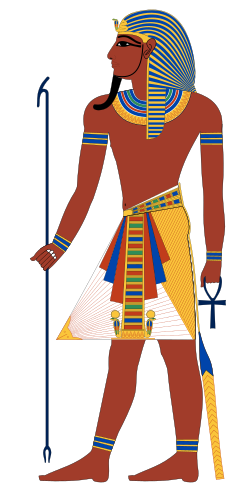30. dynastie
30. dynastie
| |||||||
Geografie
| |||||||
| Obyvatelstvo | |||||||
| Státní útvar | |||||||
| Státní útvary a území | |||||||
| |||||||
30. dynastie byla jedna ze staroegyptských královských dynastií řazených egyptology do historického období označovaného jako Pozdní doba. [1] Vládla v letech 380–343 př. n. l.[2] Je považována, podle Manehtova řazení, za poslední egyptskou dynastií, i když v historických souvislostech to neodpovídá vývoji populačních invazí do Egypta z Libye, zemí Levanty a v neposlední řadě také Nubie[3] od konce ramessovské 20. dynastie, potažmo 21. dynastie, po vzniku kněžského státu v Thebách[4] v Třetí přechodné době.[5]
Historický vývoj




Vliv invazních populací do Egypta, zejména do úrodné delty Nilu, se prosadil jak ve vládnoucích strukturách, tak i v nejvyšších funkcích egyptských faraonů, jako je 22–23. Libyjské dynastie, až v 25. dynastii ovládli Egypt králové Nubie. V celé oblasti Levanty docházelo k rozsáhlým mocenským výbojům jmenovitě Assyřanů, následně Peršanů a v konečné fázi Makedonců. 30. dynastie byla tedy poslední, pocházející z oblasti Horního a Dolního Egyptu, bez specifického určení populačního původu.
Peršané ovládli Egypt 525 př. n. l. a perský král Kambýsés přijal atributy faraona. Pět dalších následníků uplatňující svoji vládu v Egyptu, který byl pouze jednou z ovládaných provincií Perské říše, vládli prostřednictvím dosazených úředníků, satrapů. Po ~ 120 letech nadvlády v Egyptě, za Artaxerxa II., kdy již se králové Peršanů potýkali z řadou povstání v četných částech říše a také vlastními rozbroji ve vládnoucí dynastii, o nástupnictví, docházelo k oslabovaní vnitřcích struktur, takže se při rebelii v Egyptu sajskému princi Amyrtaios II. podařilo ovládnout Egypt se sídlem v Sais poté, co zemřel perský král Darius II. v roce 404 př. n. l.[1] Po asi šesti letech vlády byl svržen, a usmrcen následníkem Nefaarudžem I.
Panovníci v chronologickém řazení od 28. dynastie
| Král | rodné jméno | trůní jména | období př. n. l.[6] | poznámky | |||||||||||||||||||||||||||||||
|---|---|---|---|---|---|---|---|---|---|---|---|---|---|---|---|---|---|---|---|---|---|---|---|---|---|---|---|---|---|---|---|---|---|---|---|
| 28. dynastie Amyrtaios | 404-399 | Saiský princ libyjského původu [1];vzpoura proti Peršanům | |||||||||||||||||||||||||||||||||
| 29. dynastie Nefaarudž I. | 399-393 | Zakladatel 29. dynastie sídlo v Mendes (Delta Nilu); Svrhl, zajal a popravil předchůdce Amenardise. | |||||||||||||||||||||||||||||||||
| Pašerimut | ~393 | uzurpoval trůn na úkor syna Nefaarudže I.; vládl jen krátce;byl svržen nástupcem Hakorem (také Achoris); | |||||||||||||||||||||||||||||||||
| Hakor | 393-380 | syn Neferudže I.; opravil řadupamátek, dokončil kapli pro posvátnou bárku Amona | |||||||||||||||||||||||||||||||||
| Nefaarudž II. | ~380 | Vládl jen krátce, zachované zápisy na stéle v Hermepolis[7] | |||||||||||||||||||||||||||||||||
| 30. dynastie Nachtnebef | 380-362 | Zbudoval několik staveb v Hermapolis, Memfis, Tanis, pylon v Karnaku[6] | |||||||||||||||||||||||||||||||||
| Džedhor | 365-360 | Nachtnebefův syn; vojenské výpravy do Palestiny a Fénicie s podporou řecké Sparty a Athén | |||||||||||||||||||||||||||||||||
| Nachthareheb | 360-343 | Nachtnebefův vnuk, uzurpoval strýcův trůn, nechal opravit řadu starověkých památek; poražen Artaxerxem III. u Pelusia 343 př. n. l. |
Epilog
Tři zmíněné egyptské dynastie, které vládly v mezidobí dočasně oslabené perské nadvlády v letech ~ 404–343 př. n. l. tvoří v chronologické posloupnosti, v historickém kontextu, jeden celek propojený nezřetelnou rodovou posloupností. Bylo jejich snahou obnovit egyptskou tradici a obnovit prosperitu společnosti. Jejich snažení ukončila porážka u Pelúsia Artaxexésem III. 343 př. n. l. Jednalo se už o třetí bitvu svedenou u tohoto města s Peršany (další byly v letech 525 př. n. l. a 373 př. n. l.). Pelúsium rovněž dobude Alexandr Veliký, ovšem bez boje, vítán Egypťany jako osvoboditel od Peršanů. Vnější podmínky dané rozbroji v celé oblasti Levanty, upadajícího vlivu Perské říše a vnitřního rozkladu správních - provincionálních struktur Egyptu, vedly ke kolapsu společnosti a porážce Peršanů v bitvě u Issus v 333, od kdy nastoupila vláda Makedonců pod vedením Alexandra Velkého.[8]
Pozdní dynastické období je posledním obdobím egyptské nezávislosti za dynastií 28. až 30. (404 - 343 př. n. l.). Pokud jde o postavení Egypta ve světě, tak to byla doba jejich vojenského a diplomatického úsilí, zaměřených na zabránění opětovnému dobytí Perskou říší. Dynastie 28.-29. byly poznamenány častými výměnami panovníků, jejichž vlády často začínaly a končily násilně. Ve srovnání s tím byla 30. dynastie relativně stabilním útvarem, jehož vláda byla přerušena pouze pod vnějším vlivem za Nachtharehebovy vlády. Kulturně bylo toto období pokračováním určitých pozdně egyptských trendů (archaistické tendence, popularita zvířecích kultů, kult Osirise a božských dvojic), které se staly platformou pro vývoj v období Ptolemaiovců a řecko-římské éry.[9]
Reference
- ↑ a b c BUNSON, Margaret. Encyclpedie of Ancient Egypt [online]. New York: Facts On File, Inc., 1991. S. 36. Dostupné v archivu pořízeném dne 2021-08-30. (anglicky)
- ↑ datace podle VERNER, Miroslav; BAREŠ, Ladislav; VACHALA, Břetislav. Encyklopedie starověkého Egypta. Praha: Libri, 2007. 528 s. ISBN 978-80-7277-306-0. S. 516–521.
- ↑ ROSS, Larry. From Prehistory to the Meroitic Period [online]. Lewiston: The Edwin Mellen Press. Dostupné online. (anglicky)
- ↑ The Libyen Peroiod in Egypt [online]. Leiden: Nederlands Institute Voor Het Nnabije Oosten, 2007. Dostupné online. (anglicky)
- ↑ NAUTON, Christopher. Regime Change and The Administration of Thebes During The Twenty-fifth Dynasty [online]. Swensea Wales: Swansea University, 2011. Dostupné online. (anglicky)
- ↑ a b CLAYTON, Peter. Chronicle of the Pharaohs [online]. Thames & Hudson, 2006. S. 171–173. Dostupné online. (anglicky)
- ↑ MYŠLIWIEC, Karol. The Ewiling of Ancient Egypt [online]. London: Cornell University, 2000. S. 167. Dostupné online. (anglicky)
- ↑ BÁRTA, Miroslav; KOVÁŘ, Martin; EVŽEN, Neústupný. Kolaps a regenerace: cesty civilizací a kultur. Praha: Akademia, 2011. Dostupné online. ISBN 978-80-200-2036-9.
- ↑ LADYNIN, Ivan. Late Dynastic Period. [s.l.]: UCLA Encyklopedia Egyptology, 2013.
Externí odkazy
- Klotz David, Persien Period, J. UCLA Encyclopedia of Egyptology (1), 2015
- Colburn Henry , The archeology of Achaemenid rule in Egypt, Disertation University of Michigan 2014, [1]
 Obrázky, zvuky či videa k tématu 30. dynastie na Wikimedia Commons
Obrázky, zvuky či videa k tématu 30. dynastie na Wikimedia Commons
Média použitá na této stránce
Standard of Cyrus the Great, founder of the Persian Achaemenid Empire. Called the: Derafsh-e Shahbaz-e-Talayi or the Golden Falcon (Persian: درفش شاهباز طلایی).
- The standard is described by Xenophon of Athens in Cyropaedia (Book VII, C.1) as: "...and the word went down the lines, "Eyes on the standard and steady marching!". The standard was a golden eagle, with outspread wings, borne aloft on a long spear-shaft, and to this day such is the standard of the Persian king." (however here he is describing Artaxerxes II's standard at Cunaxa).
Autor: Jeff Dahl, Licence: CC BY-SA 4.0
The double crown symbolizing dominion over upper and lower Egypt.
Picture of a piece of bowl with the names of pharaoh Djedhor (= Teos). Faience from Memphis, 30th dynasty, Late Period.
Autor: Unknown, Licence: CC BY 2.5
Isis greeting Nectanebo II, fragment of the door of a small temple built at the entry of the alley to the Serapaeum. Painted limestone, ca. 359–341 BC (30th Dynasty). From the Serapaeum at Saqqarah.
Autor: Jeff Dahl, Licence: CC BY-SA 4.0
Pharaoh, the king of ancient Egypt, is often depicted wearing the nemes headdress and an ornate shendyt. Based on New Kingdom tomb paintings.
(c) Photograph by Rama, Wikimedia Commons, Cc-by-sa-2.0-fr
Autor: Internet Archive Book Images, Licence: No restrictions
Identifier: cu31924091762140 (find matches)
Title: History of Egypt, Chaldea, Syria, Babylonia and Assyria
Year: 1903 (1900s)
Authors: Maspero, G. (Gaston), 1846-1916 Sayce, A. H. (Archibald Henry), 1845-1933
Subjects: Civilization, Ancient History, Ancient
Publisher: London : Grolier Society
Contributing Library: Cornell University Library
Digitizing Sponsor: MSN
View Book Page: Book Viewer
About This Book: Catalog Entry
View All Images: All Images From Book
Click here to view book online to see this illustration in context in a browseable online version of this book.
Text Appearing Before Image:
eCaspian, the Cadusians and Amardians, on either side ofthe chain of mountains bordering the Iranian plateau,defied all the efforts made to subdue them.^ India and theSakge had developed from the condition of subjects intothat of friendly allies, and the savage hordes of Gedrosiaand the Paropamisus refused to recognise any authority atall.^ The whole empire needed to be reconquered andreorganised bit by bit if it was to exercise that influencein the world to which its immense size entitled it, and the 1 They appear in the history of every epoch as the irreconcilable foes ofthe great king, enemies against whom even the most peacefully disposedsovereigns were compelled to take the field in person. 2 The SaksB fought at Arbela, but only as allies of the Persians. TheIndians who are mentioned with them came from the neighbourhood ofCabul; most of the races who had formerly figured in Darius satrapy ofIndia had become independent by the time Alexander penetrated into thebasin of the Indus.
Text Appearing After Image:
VOL. IX. THE CONQUERED NATIONS 323 question arose whettier the elements of which it consistedwould lend themselves to any permanent reorganisation orreadjustment. The races of the ancient Eastern world, or, at any rate,that portion of them which helped to make its history,either existed no longer or had sunk into their dotage.They had worn each other out in the centuries of theirprime, Chaldaeans and Assyrians fighting against Cosseeansor Elamites, Egyptians against Ethiopians and againstHittites, Urartians, Armgeans, the peoples of Lebanon andof Damascus, the Phoenicians, Canaanites and Jews, untilat last, with impoverished blood and flagging energies, theywere thrown into conflict with younger and more vigorousnations. The Medes had swept away all that still remainedof Assyria and Urartu; the Persians had overthrown theMedes, the Lydians, and the Chaldseans, till Egypt aloneremained and was struck down by them in her turn. Whathad become of these conquered nations during the period
Note About Images
Autor: Jeff Dahl, Licence: CC BY-SA 4.0
Typical ancient Egyptian crook and flail. It symbolizes leadership and a powerful ruler
Autor: Ineni3000, Licence: CC BY-SA 4.0
Sarkophagdeckel des Nacht-Neb-ef
Aramaic papyrus containing a contract for a loan, dated to regnal year 5 of pharaoh Amyrtaios, in 400 BCE. From Elephantine (Upper Egypt), 28th Dynasty, Late Period.











